A Cup of Warm, Rounded Love
The Tea from Jongseong Seunim of Baengnyeonsa Temple in Gangjin
Text by. Park Hyeon-suk Photo by. Ha Ji-kwon
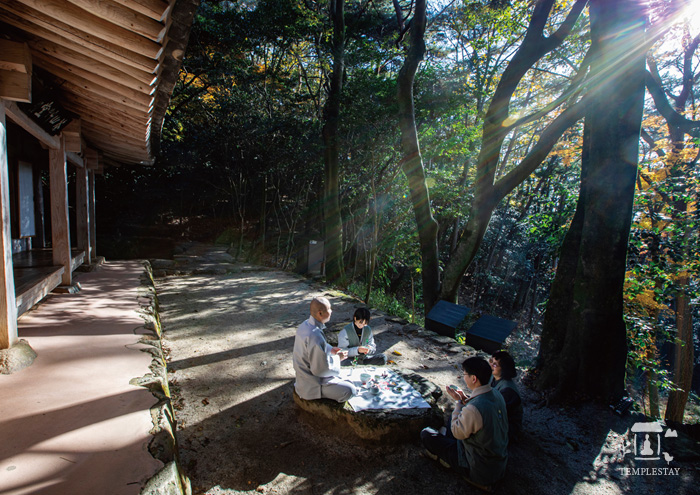
It was a day when I experienced two seasons in a single day. In the morning, my feet sank ankle-deep in the abundant first snow that fell across Seoul two days ago, but when I arrived in Gangjin in the afternoon, the sunlight and wind were as warm as early spring. When I arrived at Baengnyeonsa Temple and saw the camellia buds on the trees in front of Mangyeongnu Pavilion, it felt even more surreal.
These buds, which began to appear in November, will dye the entire Baengnyeonsa Temple area red by March of next year. An old legend suddenly came to mind as I gazed at the petals now radiating a delicate red color. The legend was about a wild strawberry that a girl found in winter deep in the mountains. A spirit told her that her mother’s illness would be cured if she brought her mother some wild strawberries so the girl set out on a journey to look for some.
In contrast to the pale white snow that fell that morning, the delicate red camelia petals were now covering the grounds of Baengnyeonsa Temple.
Reflecting on Daeungjeon Hall, Steeped in the Scent of Tea
Baengnyeonsa Temple played an important role in the revival of tea culture in the late Joseon Dynasty.
Mt. Mandeoksan, where the temple is located, is also called Dasan (tea mountain) because it has many tea trees, along with camellia trees that have grown here since the Goryeo Dynasty. As a result, the scent of tea seems to waft faintly in the wind blowing through the temple compound. The temple has two tea rooms— Mangyeong-daseol under Mangyeongnu Pavilion and Illo-hyangsil under Daeungjeon (Great Hero Hall)—making it a real “temple of tea.” On the right-hand path leading to Daeungjeon Hall is the following poem by Master Hyejang (aka. A-am), who shared a friendship with Jeong Yak-yong (aka. Dasan) that transcended religion and age, a friendship that fills my heart with the love of tea even more.
The mountain sunset reflected on the curtain is touchingly quiet, and the red sunset in the green forest fills my eyes with beauty.
I called the young monk and told him to make tea, only to find: There was clear spring water near my pillow from the beginning.
When I arrived at Daeungjeon Hall, I suddenly turned and looked back, I couldn’t help but exclaim. The sea in front of Gugangpo Port in Gangjin spread out before me like a painting. Beauty keeps your gaze lingering, and I stood there for quite a while, basking in the joy the scene gave me. The sea shone softly, as if a blue silk quilt had been spread between the sky and the foot of Mt. Mandeoksan. Jeong Yak-yong—who was exiled to Gangjin from 1801 to 1819—said, “Gugangpo is more like a lake than a sea,” and I think he was right. While Mangyeong-daseol is a tea room where any passerby can easily stop by for a cup of tea, Illo-hyangsil is where the monks of Baengnyeonsa Temple welcome guests and drink tea. This is where I met with Jongseong Seunim, who has been serving as the vice abbot of the temple for the past three years.
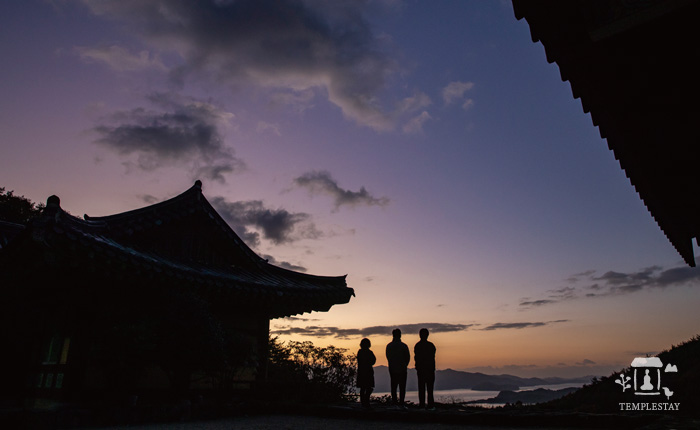
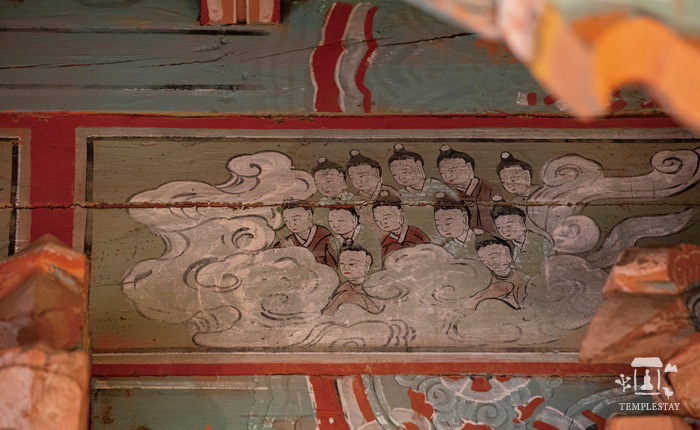
More Encounters While Seeking No Encounters
For 20 out of his 30 years of monastic life, Jongseong Seunim has been in charge of farming and making tea for the temple. He has made between 2,000 to 3,000 cases of tea a year at Daeheungsa Temple, also known as the holy land of tea, and he has taken to heart the following teachings: “Seon and farming are not separate” and “Tea and Seon are of one taste.” He told me his story with a big smile.
“Monks describe tea cultivating as a year of study or a year of practice. They prune the trees to let in more sunlight, remove kudzu vines, and pick tea leaves. There’ s a lot to do. For 20 hours a day they make tea in earnest from the second week of April to the second week of May. While roasting tea in an iron cauldron at over 300 degrees Celsius, pouring sweat, they become absorbed in it without a second thought, like a potter focused on his blazing kiln. When drying the roasted tea, their bodies have to endure the extreme temperature fluctuation, as if they were going in and out of a sauna all day. It’s part of our communal work, and I don’t think it’s that hard. However, in the past, I often wondered, ‘Why am I doing this?’ But about 10 years ago, my thinking changed, and I told myself I could grow and produce tea for the rest of my life.”
I asked him what changed his outlook on making tea, and he told me about the “power of friendship.”
“When I first thought of becoming a monk, I just wanted to sever all worldly relationships. I wanted to be completely alone. But after I became a monk, I found I still had to deal with people and relationships (laughing). Since there is no such thing as an insignificant relationship, every word I say as a practitioner should be helpful to somebody. There was a mountain of things I had to learn. Not only Buddhism but also history, philosophy, and culture. A cup of tea shared between two people becomes a medium that connects the two. It elicits kindness, encourages growth, and promotes friendship, just as it did with Dasan and Master Hyejang. Beyond just being kind, being ‘friendly’ is my goal.”
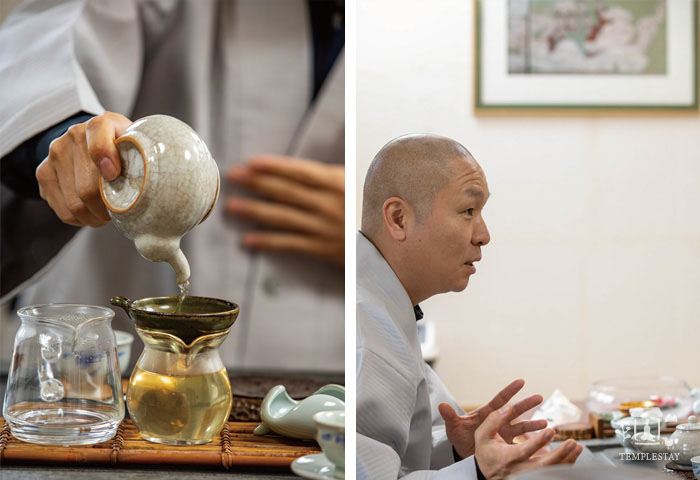
What Is the Taste of Dasan’s Tea?
I slowly pondered the meaning of “friendliness beyond kindness” and drank the Baengnyeonsa tea Jongseong Seunim gave me. Baengnyeonsa tea—grown on Mt.
Mandeoksan and made by Baengnyeonsa Temple’s monks and staff—is precious because only about 300 cases are made a year. His hands moved carefully as he showed me the tea, which was neatly packaged.
The tender, light green tea began to infuse the cold air with its clear, gentle scent. The people sitting with us also took a sip, their faces showing amazement. They each shared their own impressions with comments like: “It’s as fragrant as roasted beans,” “It’s more savory than sungnyung (made by boiling scorched rice),” and “It’s refreshing yet deep.” Master Choui is considered the saint of tea in Korea because he raised tea culture to the realm of philosophy and art. He said that the taste of tea from Mt. Mandeoksan/Dasan is like the fragrance of a baby’s skin after a bath. It embodies the subtle and profound energy that creates the universe, the taste of an innocent and uninhibited beginning.
Jongseong Seunim starts his day with a cup of tea every morning. He told me that the taste of tea is not limited to just the tea itself; it’s also affected by the energy of the people sharing it. He further said that he willingly offers dharma teachings while drinking tea.
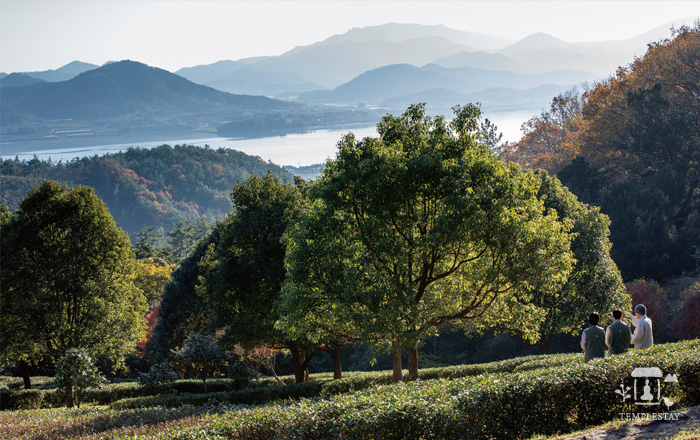
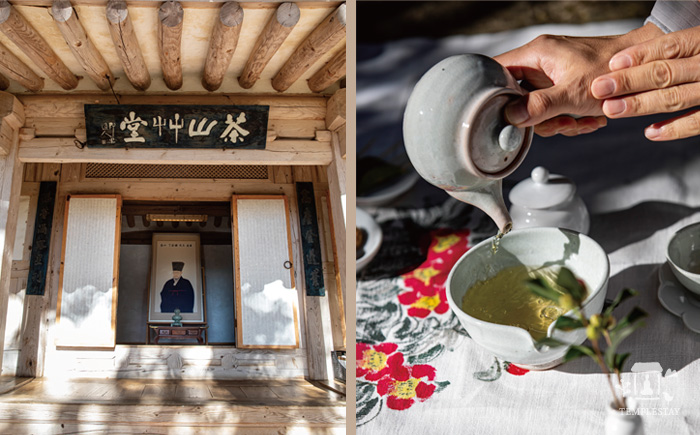
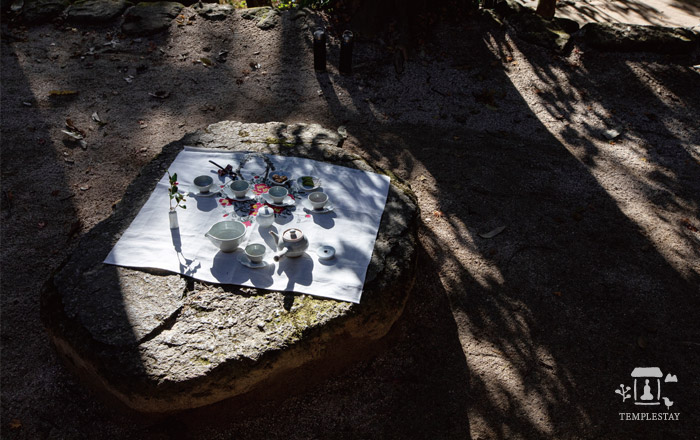
“Finally Meeting” on the Way to Dasan Chodan
The next morning, Jongseong Seunim guided us from Baengnyeonsa Temple to Dasan Chodang, carrying in his hand a basket containing Dasan’s tea and tea utensils. We walked for about 30 minutes on the same mountain path Jeong Yak-yong and Master Hyejang had walked to meet 200 years ago. As we walked, I enjoyed the greenery of the famous camellia forest, saw the ruins of Sangil-am Hermitage which had a panoramic view of Gugangpo Port, and saw the Baengnyeonsa tea fields, which seemed to have been mysteriously and beautifully arranged, like a secret garden on a sunny mountainside.
The camphor trees, cleverly planted between the tea trees, were not just for the enjoyment of the eyes, but also to protect the tea trees because their scent is effective in repelling pests. It is said that the reason there are so many camellia and tea trees planted around Baengnyeonsa Temple is because they don’t burn easily, therefore offering some protection to the temple.
As we walked, Jongseong Seunim said, “This and that are all tea trees. This is a tea tree haven! There are still tea flowers hanging over there. Tea trees and camellia are from the same family, which produce flowers and fruits at the same time. They are truly rare and precious. That’s why I chose “Finally Meeting” as the theme of our Baengnyeonsa Templestay. Just as flowers and fruits coexist, Jeong Yak-yong met and interacted with Master Hyejang. They got along well despite their differences. One was a Confucian scholar and the other a monk, and one was 10 years older. Professor Waldinger of Harvard Medical School participated in a study that tracked the lives of Harvard students, poor youths, and their descendants for 85 years. When announcing the results of the study, he said, “Happiness is not in wealth, fame, or academic background, but in ‘relationships.’ If people understand each other, share their hearts, and foster relationships that help each other grow, the world will become happier.”
The aesthetics of relationships naturally led to the topic Jongseong Seunim spoke of over tea yesterday, “From kindness to friendliness!” Five years after Dasan met Master Hyejang (1808), Dasan moved his residence to Dasan Chodang, and their relationship went from “friendliness” to “closeness.” Afterward, for about three years until Master Hyejang died, they traveled back and forth from Chodang to Baengnyeonsa Temple to interact, crossing the pass over Mt. Mandeoksan. Their relationship revolved around tea. Dasan, who was 10 years younger, even sent Master Hyejang a humorous letter asking for tea, writing, “I heard that the biggest donation for one who crosses the bridge of suffering after death is a handful of great tea which condenses the suffering and distress of a famous mountain. Please do not reject this fervent wish of a thirsty one, and grant his wish.”
I suspect Master Hyejang would have burst into laughter at such a humorous letter, written as if it were a petition to the king.
On our way back down, I suddenly asked out of curiosity, “What does tea mean to you, Seunim? What does it mean?”
He paused for a moment and said, “It is my dharma brother! Of my whole life.”
Dreaming of Having Tea as a Daily Routine
When we finally arrived at Dasan Chodang, the sun was shining brightly and the chirping of mountain birds was lively in the gentle breeze. Our tea table was set on a wide rock in the yard of the Chodang, very charming. Jongseong Seunim assumed the role of tea master as before, and I tasted the tea he offered me. He and everyone else at the table were like rocks and tea trees, silently dyed in the fullness that a cup of tea gave. As we drank the tea smiling silently, I thought I would never forget the sunlight, the wind, and the birdsong of that morning, and above all, the taste of the tea.
“Drinking tea like this is Buddhist practice, practice that prevents pain from arising in my mind. It is called ‘daily tea.’ Drinking tea naturally and often every day is the path to happiness.”
I tasted the tea brewed by Jongseong Seunim, who wants to evolve beyond kindness and cultivate friendship toward all living beings. I will remember that generous, rounded, and affectionate, warm cup of love, and practice the wisdom of enjoying tea daily.
Park Hyeon-suk is a freelance writer and interviewer. She loves Korea's traditional culture and nature, dreams of “ancient futures” (a concept proposed by Helena Norberg-Hodge) and pursuing sustainable values. She has met with individuals who embody intangible cultural assets and who pass down traditions from generation to generation. She has promoted Korean culture through the quarterly magazines Hanok and Koreana.
Baekryunsa Temple+82-10-5831-0837





